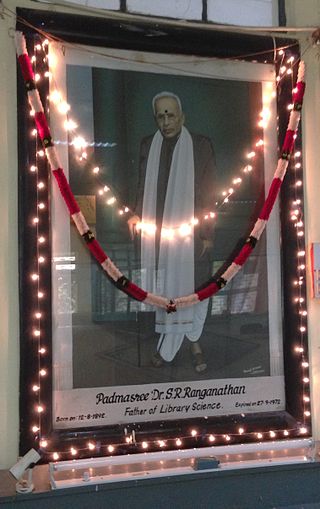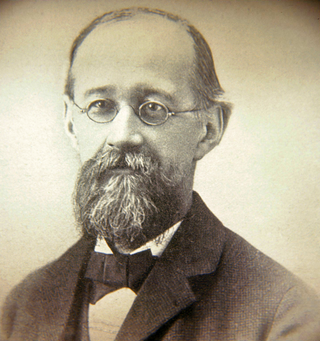Related Research Articles
The Bliss bibliographic classification (BC) is a library classification system that was created by Henry E. Bliss (1870–1955) and published in four volumes between 1940 and 1953. Although originally devised in the United States, it was more commonly adopted by British libraries. A second edition of the system (BC2) has been in ongoing development in Britain since 1977.

The Dewey Decimal Classification (DDC), colloquially known as the Dewey Decimal System, is a proprietary library classification system which allows new books to be added to a library in their appropriate location based on subject. It was first published in the United States by Melvil Dewey in 1876. Originally described in a 44-page pamphlet, it has been expanded to multiple volumes and revised through 23 major editions, the latest printed in 2011. It is also available in an abridged version suitable for smaller libraries. OCLC, a non-profit cooperative that serves libraries, currently maintains the system and licenses online access to WebDewey, a continuously updated version for catalogers.
The Library of Congress Classification (LCC) is a system of library classification developed by the Library of Congress in the United States, which can be used for shelving books in a library. LCC is mainly used by large research and academic libraries, while most public libraries and small academic libraries use the Dewey Decimal Classification system. The classification was developed by James Hanson, with assistance from Charles Martel, in 1897, while they were working at the Library of Congress. It was designed specifically for the purposes and collection of the Library of Congress to replace the fixed location system developed by Thomas Jefferson.

A library classification is a system used within a library to organize materials, including books, sound and video recordings, electronic materials, etc., both on shelves and in catalogs and indexes. Each item is typically assigned a call number, which identifies the location of the item within the system. Materials can be arrange by many different factors, typically in either a hierarchical tree structure based on the subject or using a faceted classification system, which allows the assignment of multiple classifications to an object, enabling the classifications to be ordered in many ways.

The Universal Decimal Classification (UDC) is a bibliographic and library classification representing the systematic arrangement of all branches of human knowledge organized as a coherent system in which knowledge fields are related and inter-linked. The UDC is an analytico-synthetic and faceted classification system featuring detailed vocabulary and syntax that enables powerful content indexing and information retrieval in large collections. Since 1991, the UDC has been owned and managed by the UDC Consortium, a non-profit international association of publishers with headquarters in The Hague, Netherlands.

This page is a glossary of library and information science.

Shiyali Ramamrita Ranganathan was a librarian and mathematician from India. His most notable contributions to the field were his five laws of library science and the development of the first major faceted classification system, the colon classification. He is considered to be the father of library science, documentation, and information science in India and is widely known throughout the rest of the world for his fundamental thinking in the field. His birthday is observed every year as National Librarian Day in India.

Charles Ammi Cutter was an American librarian. In the 1850s and 1860s he assisted with the re-cataloging of the Harvard College library, producing America's first public card catalog. The card system proved more flexible for librarians and far more useful to patrons than the old method of entering titles in chronological order in large books. In 1868 he joined the Boston Athenaeum, making its card catalog an international model. Cutter promoted centralized cataloging of books, which became the standard practice at the Library of Congress. He was elected to leadership positions in numerous library organizations at the local and national level. Cutter is remembered for the Cutter Expansive Classification, his system of giving standardized classification numbers to each book, and arranging them on shelves by that number so that books on similar topics would be shelved together.
A faceted classification is a classification scheme used in organizing knowledge into a systematic order. A faceted classification uses semantic categories, either general or subject-specific, that are combined to create the full classification entry. Many library classification systems use a combination of a fixed, enumerative taxonomy of concepts with subordinate facets that further refine the topic.
Henry Evelyn Bliss was the author of a classification system he called Bibliographic Classification which is often abbreviated to BC and is sometimes called Bliss Classification. He was named one of the 100 most important leaders in the field of library and Information science in the 20th century by American Libraries in December 1999, which praised his “subject approach to information” as “one of the most flexible ever conceived.” Despite these praises, Bliss was “met with apathy and even derision in his efforts” during his lifetime. His classification system was generally disregarded in favor of other more established classification systems such as the Dewey Decimal System created by Melvil Dewey and the Library of Congress Classification system, causing “more than one author” to label him as a, “prophet without honor.” Although Bliss was an American, his system was more popular in British libraries than in American libraries. A second edition of the system has been developed in the United Kingdom in 1977. Several volumes have been published.

The following outline is provided as an overview of and topical guide to library and information science:
The Korean Decimal Classification (KDC) is a system of library classification used in South Korea.
Knowledge organization (KO), organization of knowledge, organization of information, or information organization is an intellectual discipline concerned with activities such as document description, indexing, and classification that serve to provide systems of representation and order for knowledge and information objects. According to The Organization of Information by Joudrey and Taylor, information organization:
examines the activities carried out and tools used by people who work in places that accumulate information resources for the use of humankind, both immediately and for posterity. It discusses the processes that are in place to make resources findable, whether someone is searching for a single known item or is browsing through hundreds of resources just hoping to discover something useful. Information organization supports a myriad of information-seeking scenarios.
The British Catalogue of Music Classification is a faceted classification that was commissioned from E. J. Coates by the Council of the British National Bibliography to organize the content of the British Catalogue of Music. The published schedule (1960) was considerably expanded by Patrick Mills of the British Library up until its use was abandoned in 1998. Entries in the catalogue were organized by BCM classmark from the catalogue's inception in 1957 until 1982. From that year the British Catalogue of Music was organized instead by Dewey Decimal Classification number, though BCM classmarks continued to be added to entries up to the 1998 annual cumulation.
Derek Austin was a British librarian and author.

The Swiss Book is the National Bibliography of Switzerland and is compiled, edited and published by the Swiss National Library (NL). The Swiss Book indexes Swiss publishing output – the Helvetica – published in print and/or electronic form in Switzerland and abroad, in accordance with the NL's acquisitions guidelines.
In library and information science documents are classified and searched by subject – as well as by other attributes such as author, genre and document type. This makes "subject" a fundamental term in this field. Library and information specialists assign subject labels to documents to make them findable. There are many ways to do this and in general there is not always consensus about which subject should be assigned to a given document. To optimize subject indexing and searching, we need to have a deeper understanding of what a subject is. The question: "what is to be understood by the statement 'document A belongs to subject category X'?" has been debated in the field for more than 100 years
Jack Mills was a British librarian and classification researcher, who worked for more than sixty years in the study, teaching, development and promotion of library classification and information retrieval, principally as a major figure in the British school of facet analysis which builds on the traditions of Henry E. Bliss and S.R. Ranganathan.
Dewey-free refers to library classification schemes developed as alternatives to Dewey Decimal Classification (DDC). Dewey-free systems are often based on the BISAC subject headings developed by the Book Industry Study Group, and are typically implemented in libraries with smaller collections. Instead of using numerical notation to indicate a document's shelving location, Dewey-free systems organize documents alphabetically by natural language words. Dewey-free systems have been implemented in both public and school libraries.
Jennie Dorcas Fellows, also known as Dorcas Fellows and Dorkas Fellows, was an author and instructor of library cataloging at the New York State Library. Her book, Cataloging Rules, originally published in 1914 as bulletin 36 of the New York State Library School, remains in print in its many editions and formats.
References
- ↑ "British National Bibliography - British publication".
- ↑ "IFLA -- British National Bibliography". www.ifla.org.
- ↑ Lowery, John. "The British National Bibliography". www.bl.uk.
- ↑ Ingleby, Andi. "British National Bibliography - this week's new BNB records". www.bl.uk.
- ↑ The British National Bibliography 1950-1973 : a catalogue of achievement / Andy Stephens. London : British Library, 1994. ISBN 0-7123-1069-X
- ↑ Walford, A. J. (ed.) Walford's Concise Guide to Reference Material. London: Library Association, 1981; p. 6
- ↑ Supplementary classification schedules : prepared to augment the Dewey Decimal Classification for use in the "British National Bibliography" and first introduced in January 1960. London : British National Bibliography, 1963.